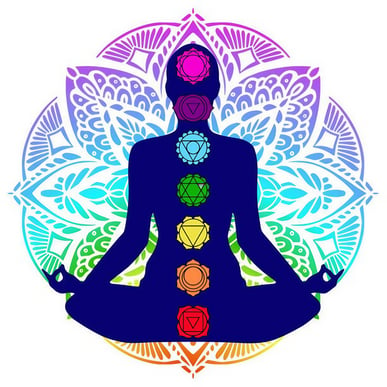Explore Chakras: Healing & Energy Alignment Tips
Welcome to spritcrafted your ultimate resource for understanding and balancing chakras. Discover insightful articles on chakra meditation, yoga poses for energy alignment, and essential oils f...
10/14/20245 min read


Introduction to Chakras
Chakras are energy centers located throughout the body, integral to various spiritual and physical practices. Rooted in ancient traditions, particularly within Hinduism and Buddhism, the concept of chakras has garnered attention worldwide, transcending its cultural origins to become a significant aspect of holistic health and wellness. The term “chakra” derives from the Sanskrit word meaning "wheel," signifying the constant movement of energy through these vital points.
There are seven primary chakras, each associated with distinct qualities and functions. They include the Root (Muladhara), Sacral (Svadhisthana), Solar Plexus (Manipura), Heart (Anahata), Throat (Vishuddha), Third Eye (Ajna), and Crown (Sahasrara) chakras. These energy centers are aligned along the spine, extending from the base to the crown of the head. Each chakra is linked to specific physical, emotional, and spiritual aspects of an individual’s life, influencing overall well-being.
The proper functioning of chakras ensures a balanced flow of energy throughout the body. When these energy centers are blocked or imbalanced, it can lead to various physical ailments, emotional disturbances, and spiritual disconnection. Therefore, maintaining chakra balance is essential for enhancing vitality and achieving a state of holistic health. Various methods such as meditation, yoga, sound therapy, and energy healing practices are utilized to cleanse and balance these chakras, promoting harmony within the body and mind.
Understanding and integrating the chakra system into everyday practices can significantly improve one's life quality. This awareness not only fosters a deeper connection to oneself but also cultivates a profound respect for the interconnectedness of all elements of existence.
To begin balancing your chakras, try incorporating this chakra balancing kit into your practice.
Understanding Each Chakra: Locations and Meanings
The concept of chakras derives from ancient traditions and represents essential energy centers within the human body. Each of the seven chakras has a unique location, color, and symbolic meaning, contributing to physical, emotional, and spiritual well-being.
The first chakra, known as the Root Chakra, is situated at the base of the spine. It is represented by the color red, symbolizing stability and grounding. This energy center governs our basic needs, such as safety, security, and survival. A balanced Root Chakra fosters a sense of belonging and inner strength. To support this, using sandalwood essential oil during meditation can enhance your grounding practice.
Next is the Sacral Chakra, located in the lower abdomen, roughly two inches below the navel. Its associated color is orange, embodying creativity, joy, and passion. This chakra influences our emotions, relationships, and sexual energy. When balanced, the Sacral Chakra enhances our ability to connect with others and embrace change. Enhance your practice with a Sacral Chakra healing crystal to boost creativity and joy.
Moving upward, the Solar Plexus Chakra can be found in the upper abdomen, just above the navel. It is represented by the color yellow and is linked with personal power, confidence, and self-esteem. A well-adjusted Solar Plexus Chakra empowers individuals to take initiative and assert their will in various aspects of life. Consider adding a citrine crystal to your chakra healing toolkit to strengthen your personal power.
In the center of the chest lies the Heart Chakra, which is associated with the color green. This chakra symbolizes love, compassion, and forgiveness. It governs our ability to experience affection and develop meaningful connections. A balanced Heart Chakra enhances emotional resilience and promotes harmony in relationships. A rose quartz crystal can help open your heart and foster unconditional love.
Transitioning to the throat, the Throat Chakra is responsible for communication and self-expression. Its blue hue represents clarity and truth. This chakra enables the articulation of thoughts and feelings, and a balanced Throat Chakra encourages effective verbal interactions. Use a blue lace agate crystal to support clear and authentic communication.
Above the eyebrow is the Third Eye Chakra, associated with intuition and insight. Its indigo color fosters awareness and perception beyond the physical realm. A well-aligned Third Eye Chakra enhances one's ability to perceive intuition and access deeper understanding. Meditate with an amethyst crystal to enhance spiritual awareness and intuition.
Finally, the Crown Chakra is located at the top of the head and is represented by the color violet. It signifies spiritual connection and enlightenment. A balanced Crown Chakra fosters a sense of unity with the universe and aids in achieving higher states of consciousness. Use clear quartz to connect to higher consciousness and spiritual growth.
Balancing the Chakras: Techniques and Practices
Balancing the chakras is essential for maintaining not only physical wellness but also emotional and spiritual harmony. There are numerous techniques that can be integrated into daily routines to ensure that each chakra remains balanced and aligned. One of the most effective methods is meditation, tailored specifically to each chakra. For instance, during meditation aimed at the root chakra, one may focus on stability and grounding, often visualizing a vibrant red color, symbolizing strength. Similarly, when meditating on the heart chakra, which is associated with the color green, individuals can concentrate on love and compassion.
Another beneficial practice for chakra balancing involves the use of crystals, which are believed to resonate with the energy of the respective chakras. For example, amethyst is often linked to the crown chakra, promoting spiritual connection and enlightenment. In contrast, citrine is thought to activate the solar plexus chakra, encouraging personal power and confidence. Incorporating these crystals into one's environment—either by wearing them as jewelry or placing them on chakra points during meditation—can significantly enhance one’s chakra-balancing efforts.
Yoga is also a powerful tool for chakra alignment. Specific poses can target different chakras, promoting energy flow and physical well-being. For example, poses like the tree pose can stimulate the root chakra, while heart-opening postures such as camel pose contribute to a balanced heart chakra. Additionally, integrating essential oils through aromatherapy can support chakra health. Oils like sandalwood may help ground the root chakra, whereas rose oil is often used to open and heal the heart chakra. Equip yourself with a comfortable yoga mat to start practicing chakra-aligning yoga.
By incorporating these techniques—meditation, crystals, yoga, and aromatherapy—into everyday life, individuals can cultivate a harmonious chakra system. Regular practice is key to achieving long-lasting balance and overall well-being.
The Importance of Chakra Wellness
In this exploration of the seven chakras, we have delved into their unique locations, associated colors, and various techniques for promoting balance and harmony. Each chakra serves a vital role in our overall well-being, impacting not only our physical health but also our emotional and spiritual states. Understanding this intricate system allows individuals to identify energy blockages that may lead to stress, anxiety, or physical ailments.
Chakra wellness is an essential aspect of holistic health, as aligned and balanced chakras contribute to a more fulfilling life. The root chakra, connected to our sense of security, sets the foundation for confidence and stability. As we progress through the sacral, solar plexus, heart, throat, third eye, and crown chakras, we find a pathway toward heightened emotional intelligence, effective communication, and spiritual awareness. Embracing practices such as meditation, yoga, breathwork, or crystal healing can profoundly enhance the flow of energy within this system, promoting vitality and clarity.
We encourage readers to explore their own chakra systems and to cultivate practices that resonate with them on a personal level. Engaging in community activities, such as group meditations, workshops, or classes focused on chakra healing, can provide valuable support and deepen one's understanding. Resources, such as books or online courses, can further enrich your knowledge and facilitate your journey towards balance.
Ultimately, the pursuit of chakra wellness is an invitation to foster self-awareness and personal growth. By integrating the insights gained from this exploration, individuals can enhance their physical, mental, and spiritual lives, contributing to a sense of interconnectedness and harmony with themselves and the world around them.


SpritCrafted
Explore spirituality, crystals, and energy healing.
Harmony
Balance
© 2024. All rights reserved.


